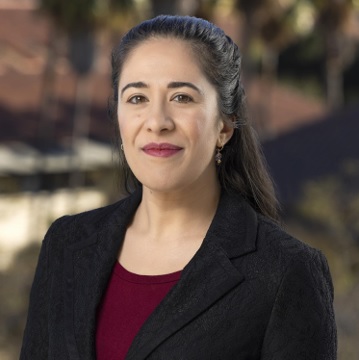Two Sigma has long collaborated with preeminent professors from top universities through consulting engagements, sabbaticals, research awards, and full-time positions within the firm.
Dr. Madeleine Udell is Assistant Professor of Management Science and Engineering at Stanford University, with an affiliation with the Institute for Computational and Mathematical Engineering (ICME) and courtesy appointment in Electrical Engineering. She was previously a tenured Associate Professor of Operations Research and Information Engineering.

Her research aims to accelerate and simplify large-scale data analysis and optimization, with impact on challenges in healthcare, finance, marketing, operations, and engineering systems design, among others. Her work in optimization seeks to detect and exploit novel structures, leading to faster and more memory-efficient algorithms, automatic proofs of optimality, better complexity guarantees, and user-friendly optimization solvers and modeling languages. Her work in machine learning centers on challenges of data preprocessing, interpretability, and causality, which are critical to practical application in domains with messy data.
Her awards include the Kavli Fellowship (2023), Alfred P. Sloan Research Fellowship (2021), a National Science Foundation CAREER award (2020), an Office of Naval Research (ONR) Young Investigator Award (2020), a Cornell Engineering Research Excellence Award (2020), an INFORMS Optimization Society Best Student Paper Award (as advisor) (2019), and INFORMS Doing Good with Good OR (2018).
We recently asked Dr. Udell about her work at Stanford and with Two Sigma.
What is your area of research?
My goal is to make data-driven decision making easier and more accessible. This motivation drives my interest in large-scale optimization, which is foundational to rational decision making, and (as a bonus) leads to beautiful mathematical theory. It also drives my interest in the inputs to these optimization problems—both the data and the models—and has led me to research simpler and more interpretable prediction methods, and more recently, how to use large language models to more efficiently model and solve complex decision making problems.
Your academic background and much of your research is in convex optimization. At the same time, much of the optimization in ML and AI is empirically driven by highly non-convex problems, and lacks the theoretical foundations of methods from the convex lineage. Do you see that as a problem or an opportunity for researchers?
Now, that’s an interesting story. I suspect that much of the success in deep learning comes not from learning to optimize on a non-convex landscape (e.g., hopping from local minimum to local minimum) but rather from choosing architectures (resnets, and later transformers, with wide hidden layers) that are easy to initialize in a locally almost-convex region near a global solution, where simple algorithms like Adam work well. Some of the most interesting work in deep learning theory has validated these suspicions.
But these architectures are also incredibly wasteful. They are extremely overparameterized relative to the size of the network that should be necessary to learn from the data. My hope is that ideas from (probably classical) optimization can inform the co-design of new optimizers and cheaper, more energy-efficient network architectures that will still be able to perform the feats of modern deep learning.
Adjacent to optimization, you have worked on missing data, matrix sketching, interpretability, and other similar areas. We’d love to hear about a data science problem that has driven your research lately.
I’ve been really interested in how to handle missing values in the context of prediction since my PhD days. One of the most obvious ideas is to try to fill in (“impute”) these missing values, and then predict as usual. I’ve experimented with a wide range of imputation methods during my research career, including matrix factorization methods, methods based on statistical models like the Gaussian copula, tree-based models, and deep learning models.
What if the fact that the values are missing is useful information for the predictive task?
But more recently, I noticed that filling in missing values is exactly the wrong thing to do if the missing values are informative: What if the fact that the values are missing is useful information for the predictive task? My lab wrote a paper that showed that adding missing indicators (1 for missing, 0 otherwise) to the set of features essentially always improves predictive performance, and often helps so much that even simple imputation methods (like imputing 0) work as well as complex ones. Using missing indicators is a very simple, but very powerful trick!
How does collaborating across academia and industry add to your research?
I believe that optimization is a service field: We should be helping to solve the trickiest problems faced by decision makers and scientists. My rule in research is only to work on problems for which I know at least one potential user. So it’s extremely useful to me to know a broader range of problems that need solving—it helps keep my research relevant, and motivates me to search for solutions to the problems that are still unsolved, rather than restricting my focus to marginal improvements to known algorithms.
You’ve collaborated with Two Sigma for more than three years. Can you elaborate on the partnership and why this is important to you?
The technical knowledge and rigor of Two Sigma researchers is incredibly deep, particularly in optimization and machine learning. So it’s great fun for me to get to think about the problems that they find challenging—these are problems that really are right up at the edge of solvability, that require really creative, innovative solutions.
…these are problems that really are right up at the edge of solvability, that require really creative, innovative solutions.
We like to say we work in the financial sciences, bringing a scientific perspective to financial services. How does that show up for you?
I’ve been impressed by the curiosity and attention to detail I see in the researchers at Two Sigma. They’re constantly thinking about the foundational ideas that power the algorithms they use, questioning assumptions, and inventing entirely different approaches—and then doing the careful follow-up work needed to validate or disprove their hypotheses.
What, outside of your work, has sparked your curiosity recently?
I grew up in California and moved back recently to start my position at Stanford. It’s a common complaint that California doesn’t have seasons. Now, any Californian would tell you that there’s a rainy season (winter) and dry season (the rest). But until recently I hadn’t understood how common gardening practices (planting exotic species and watering them regularly) create this misperception. Native California plants, which rely (almost) exclusively on the winter rain, are not at all static.
This year I performed an experiment, removing all supplemental water from my front yard. I scattered a native wildflower seed mix outside my house, and was delighted to see a different species blooming every week or two, for months, with no supplemental water. Many surprises have grown, too, in this thirsty landscape: coyote brush, milkweed, black American nightshade, and a tomato plant that actually produced edible tomatoes before succumbing to the heat of fall. Meanwhile the garden is livelier than ever, with ladybugs, butterflies, birds, and rabbits all enjoying the plants.






